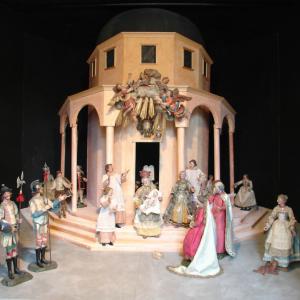The collection of crib figures, preserved and partially exhibited at the Luxoro Museum, is notable both for its size and the variety of it’s elements, counting almost four hundred pieces mainly from the Genoese school dating from the 18th and 19th centuries, but also including works from the Neapolitan, Lombard and Sicilian schools. The works are collected in a room which is a legacy of Matteo Luxoro - the most passionate admirer of this particular type of work among the three brothers, and is divided into thematic showcases and areas for installations. The presentation of the protagonists and supporting actors finds space in the first display case: the Nativity group is led by the Madonna who, richly dressed, wears a silver crown (a reference to her coronation as Queen of Genoa - which took place in 1637) with St. Joseph dressed in a cassock who, following an apocryphal tradition, holds a lily-flowered stick. Followed by commoners and nobles, rustic shepherds, the three kings and characters of their rich and multi-ethnic entourage, as well animals of various kinds.
The second display case is dedicated, making clear stylistic comparisons, to the theme of attribution to the various schools and authors, debunking the legend that would indicate as the main, if not the exclusive, architect Anton Maria Maragliano (1664-1739) and highlighting, alongside others, the personality and mastery of Pasquale Navone (1746-1791), who might be considered as the follower of the Maestro, although born seven years after his death. The third display case highlights the differences between the Genoese and Neapolitan construction techniques, through a comparison of bare mannequins: the Genoese mannequin in carved polychrome wood, while the Neapolitan ones are composed of terracotta and wooden elements mounted on a wire mannequin covered with tow. The display therefore includes some figures from the Neapolitan school, as well as the particular Genoese typology entirely sculpted and polychrome, along with scenographic elements such as rustic tools and precious objects.
The room is completed by a Neapolitan “scarabattola”, a Sicilian one attributed to Giovanni Antonio Matera (1653-1718), then an eighteenth century crib of the Lombard school with painted and outlined cardboard silhouettes and finally by the rare scene of the “Presentation in the Temple”, which in the sequence of the Christmas cycle, was the final act of the representation of that sort of baroque theatre that was the nativity scene, both in it’s religious and in the secular dimension within a noble Genoese household. The works which are not on display are stored, but (when the museum is open) they can (by appointment) be visited by scholars. The presentation solution adopted allows the exhibition to vary and include temporary displays. Over the years, installations in prestigious museum venues in Genoa and beyond have been frequent. The care of the collection is entrusted to Simonetta Maione, ably assisted by the generous collaboration of Giulio Sommariva.
Figurine del Presepe /6

Figurine del Presepe /6

Figurine del Presepe /6

Figurine del Presepe /6

Figurine del Presepe /5

Figurine del Presepe /5

Figurine del Presepe /5

Figurine del Presepe /5

Figurine del Presepe /3

Figurine del Presepe /3

Figurine del Presepe /3

Figurine del Presepe /3

Presentazione al Tempio

Presentazione al Tempio

Presentazione al Tempio

Presentazione al Tempio

Figurine del Presepe /1

Figurine del Presepe /1

Figurine del Presepe /1

Figurine del Presepe /1





